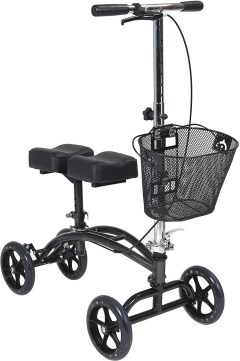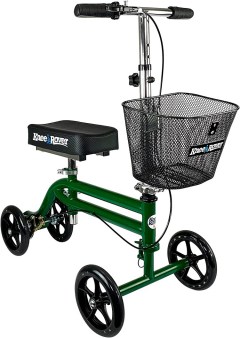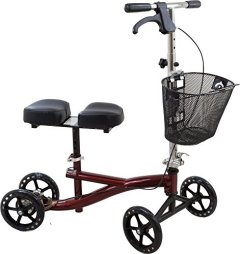BestReviews is reader-supported and may earn an affiliate commission. Details

Durable model with a strong frame and built-in safety features to limit falls.
Large and wide tires easily traverse all terrain types. Prevents spills, slips, and falls. Durable and intuitive frame provides additional stability to riders. Reliable handbrake. Built for users between 5 feet 5 inches and 6 feet 7 inches. Durable and reliable with a weight capacity exceeding 300 feet.
Handlebars may be too skinny for some users' preferences.

Comfortable, adjustable option that’s ideal for anyone dealing with foot and ankle breaks, sprains, ulcers, surgery recovery, or amputation.
Two-piece cushion provides greater comfort than many competitors. Cushion can also be adjusted to suit the height of the user. Deluxe dual braking system maximizes safety. Sturdy steel frame is extremely durable. Includes removable front basket too.
Turning radius isn’t very tight so it can be difficult to maneuver in tight spaces.

A high-performing, easy-to-use model from one of the most trusted brands in the industry.
Offers significant control and stability while steering. Knee rest features 3.5 inches of contoured padding for added comfort. Locking handbrake secures the scooter while getting on and off, and reliable rear drum brakes allow for quick stopping. Handy basket makes it easy to carry your belongings.
Wheels can come loose over time and folding mechanism may be difficult to engage.

A folding scooter perfect for taking with you on trips and errands. Steering and wheel design seem to make it better for indoor use.
Well designed for indoor and limited outdoor use. 8-inch hard wheels. Easily adjustable knee platform and handle height. Scooter folds at the handlebars to increase portability. Adjustable hand brake. Grips are padded for comfortable use. Removable basket.
Some noticed the padding seemed to wear unevenly. May not perform well on rough or uneven surfaces.

We recommend these products based on an intensive research process that's designed to cut through the noise and find the top products in this space. Guided by experts, we spend hours looking into the factors that matter, to bring you these selections.

When you’re suffering from a leg or foot injury, dealing with the pain is difficult enough. Making matters worse, you have to use crutches to get around without putting weight on the injury. But if you’re tired of using crutches or unable to do so, you don’t have to spend your recovery stuck on the couch. With a knee scooter, you can get around easily and safely, ensuring that your daily routine isn’t disrupted.
A knee scooter, which is sometimes referred to as a knee walker, resembles a traditional scooter, but instead of a footrest, it features an elevated knee rest where you place your injured leg. You place your good leg on the ground to propel yourself forward. A knee scooter’s handlebars make it easy to direct the scooter where you want to go. A knee scooter can work effectively for a variety of injuries, including a broken foot, broken ankle, sprained ankle, Achilles tear, Achilles rupture, and healing after foot or ankle surgery.
For the smoothest recovery, you have to select the right knee scooter for your specific needs. That means deciding whether you want a steerable or non-steerable model, what type of brakes to choose, and what other features will make it as easy as possible to get around.

When you’re choosing a knee scooter, it’s important to consider where you’ll be using it. There are two main types of scooters, traditional and all-terrain. Be sure to select the type that will work wherever you need it to roll.
Traditional knee scooters have small, thin wheels that work well when riding indoors or on paved surfaces. If you use a traditional knee scooter outdoors, it may tip over when you go over rugged terrain or uneven surfaces. Think rocks or cracks in the sidewalk. That said, you’ll pay less for a traditional scooter, so it can be a good option if you’re on a budget.
An all-terrain knee scooter is your best bet if your routine regularly takes you outdoors. All-terrain models have large, wide wheels that can easily handle rocky roads and wooded trails. Some all-terrain knee scooters even have inflatable wheels that allow you to customize their size. Since these models can be more expensive, they may not be the best choice if you’re on a budget.
If you’re concerned about how easily you’ll be able to maneuver around obstacles on a knee scooter, it’s important to consider whether a steerable or non-steerable model is best for you.
Steerable knee scooters allow you to turn the scooter using the handlebars. That makes it much easier to maneuver around obstacles both indoors and outdoors. However, a steerable knee scooter isn’t as stable on uneven surfaces and can lurch when you go over bumps.
With a non-steerable knee scooter, you have to lift the front portion of the scooter and physically turn it around to change your direction. Because that can be difficult to do when you’re injured, you may have a tough time getting around obstacles. However, a non-steerable model is more stable on uneven surfaces so it may work better for outdoor use.
A knee scooter’s brakes are an important safety feature to consider when you’re shopping. Disc brakes, which are located at the rear of the scooter, are effective for slowing down the scooter if you’re going too fast. A parking brake keeps the scooter stable when you’re getting on and off. The parking brake is usually located on the handlebars and should have a locking feature to prevent the scooter from sliding out from under you as you’re getting off.




















Because you rest your knee on the scooter’s knee platform, you want to be sure that the scooter is as comfortable as possible to allow for regular riding. Most knee scooters feature padded knee rests, but some models offer thicker padding than others for greater comfort. Opt for a knee scooter with approximately three inches of padding to cushion your knee as you ride.
It’s also a good idea to choose a knee scooter with a contoured knee pad. This type of pad has a slightly rounded indent that fits the shape of your knee so your leg doesn’t shift around too much while you’re riding the scooter.
If you need a knee scooter that can accommodate a wide range of users, choose an adjustable model. Both the knee rest and handlebars should be adjustable so you can raise or lower them based on what’s most comfortable for each user’s height. If you use a scooter with a pad or steering column that’s too low or high, you may actually wind up putting too much pressure on your injury or cause another injury by putting too much pressure on the unaffected leg.
A knee scooter’s weight is an important factor to consider because you may need to lift it at various times, such as when you’re loading and unloading your car. If the scooter is too heavy, you’ll have a difficult time picking it up and taking it with you on the go. Opt for a knee scooter that weighs approximately 20 pounds or less because anything heavier is usually too cumbersome to lift easily.
In addition to the weight of the knee scooter itself, pay attention to the weight limit for users as well. Many scooters have a maximum weight of at least 300 pounds, but check the product specifications to make sure that you can safely use any model you’re considering
Even if a knee scooter doesn’t weigh much, it may be difficult to fit it in the backseat or trunk of a car. To make it easier to move and store your scooter, choose a model with a quick folding feature that allows you to fold the scooter when necessary.
Many knee scooters require you to use both of your hands to operate or steer. That can make it difficult to carry your belongings when you’re on the go. To avoid struggling with your items, opt for a knee scooter that’s equipped with a front basket where you can place any items you need to take with you, such as your purse, jacket, phone, or lunch bag.
If you want a knee scooter that doesn’t include a basket, you can also buy a basket separately and attach it to the scooter.
Even if a knee scooter has a well-padded knee rest, the platform may not be as comfortable as you’d like it to be. Scooter knee pads are often covered with a vinyl material, which, though easy to clean, can cause your skin to stick to it if you’re sweating. In an effort to prevent uncomfortable chafing or irritation, some scooters include a cover for the knee rest that’s made of a soft, moisture-wicking material that can keep you cool and comfortable while you’re using your scooter.

Knee scooters vary in price based on their type, whether they’re steerable, and the features that they offer. Most models range from $55 to $429.
Inexpensive: The most affordable knee scooters are traditional, non-steerable models. They usually offer a few special features, such as a folding mechanism and adjustable knee pads, and cost between $55 and $105.
Mid-range: Traditional, steerable knee scooters are more expensive. They usually offer the same features as non-steerable scooters and more, including handlebars, a basket, and locking bakes, and cost between $105 and $245.
Expensive: The most expensive knee scooters are usually all-terrain, steerable models that are suitable for rugged outdoor use. They typically provide a range of special features, such as a folding mechanism, adjustable knee pad and handlebars, basket, and locking bakes, and cost between $245 and $429.
Get used to using a knee scooter around your home before taking it outside, ensuring that you’re comfortable and in control of the scooter before you transition to an outdoor setting.
For safety reasons, never use a knee scooter to go up or down stairs and steps. Avoid escalators as well.
Always keep both of your hands on the handlebars when you’re operating a knee scooter. Taking one of your hands off the bars may cause you to fall.
Wear comfortable, supportive shoes with a non-slip sole when you’re using a knee scooter.
There are so many knee scooters to choose from that you’re guaranteed to find a model that fits your needs perfectly. The KneeRover All Terrain KneeRover Steerable Knee Scooter is an ideal option if you want to maintain an active outdoor lifestyle while you’re recovering from an injury. Its 12-inch pneumatic tires can handle nearly any terrain, including dirt, gravel, and grass, and the simple folding mechanism allows you to easily store and transport the scooter. We also like the Roscoe Knee Scooter because its sturdy design is not only durable but can also hold up to 350 pounds. It also includes a basket for your belongings and doesn’t require any tools to assemble.

Q. Why should I use a knee scooter instead of crutches?
A. Using crutches requires upper body strength that some people just don’t have. Even people who are strong enough will find it difficult to carry items while using crutches. Attaching a basket or cup holder to your knee scooter makes transporting items much more convenient.
Q. Are there any injuries a knee scooter shouldn’t be used for?
A. A knee scooter is a poor option if you have injuries to both feet or ankles. In some cases, you should avoid using a scooter if you’re recovering from knee or hip surgery, but it’s always best to consult with your doctor if you’re not sure whether you’re a candidate for a knee scooter.
Q. Do knee scooters work on carpeting?
A. Knee scooters usually work on carpeted flooring. However, you should be careful when you’re moving from one type of floor to another. For example, you should move extremely slowly over any bumps or uneven areas when you transition between a carpet and hardwood floor.
Get emails you’ll love.
Learn about the products you’re wondering if you should buy and get advice on using your latest purchases.
